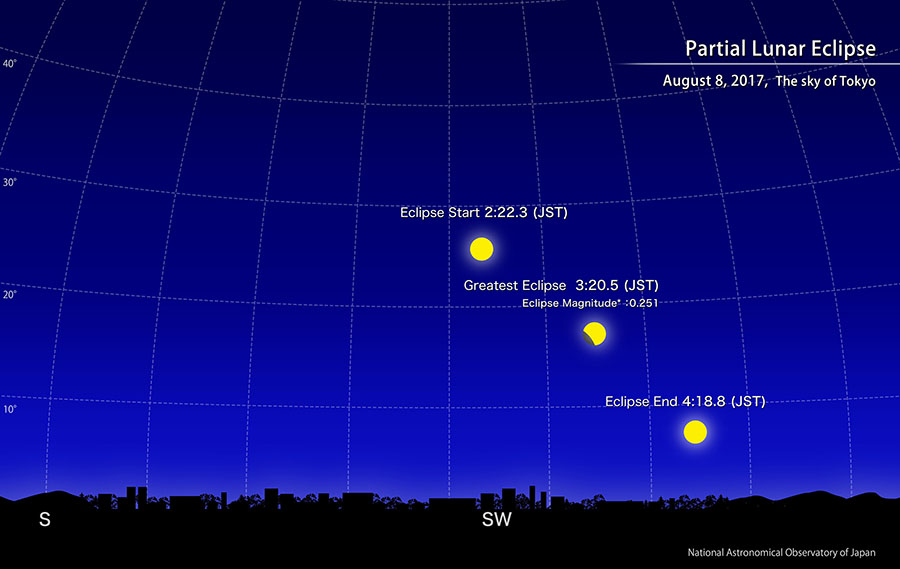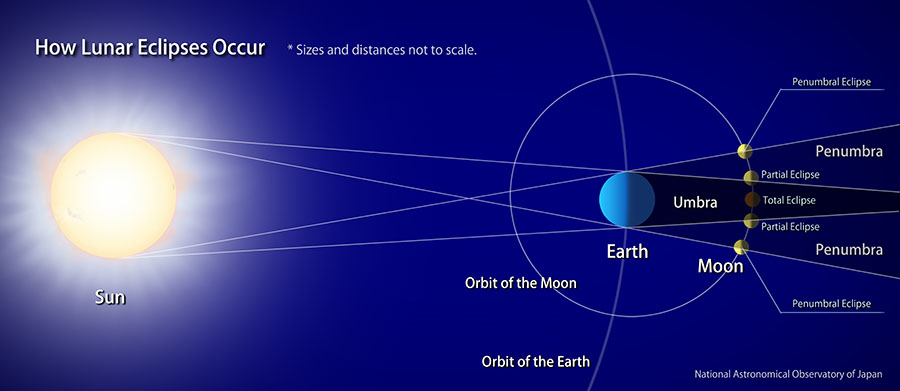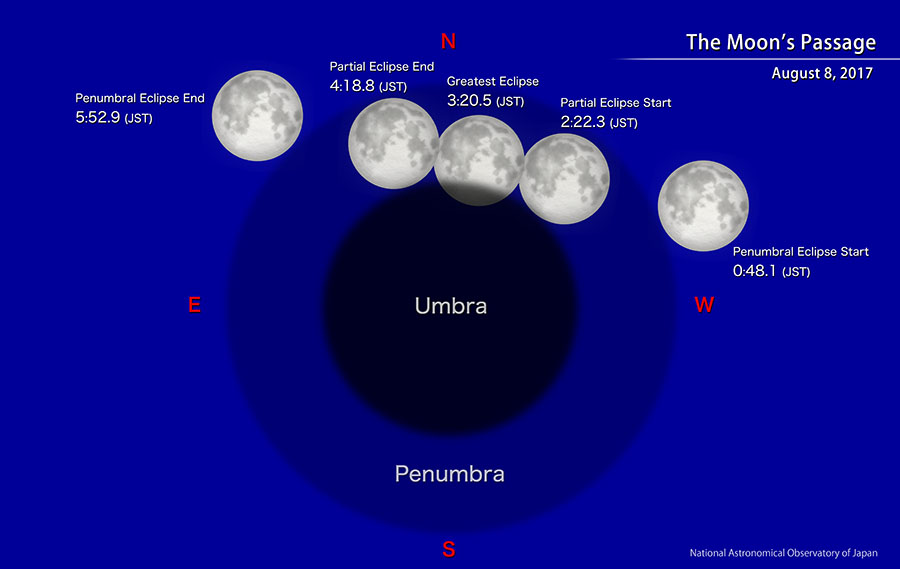Partial Lunar Eclipse All Over Japan (August, 2017)

Let’s Watch the Chipped Moon in the Early Morning!
A partial lunar eclipse occurs early in the morning of August 8. You can observe this partial lunar eclipse from all over Japan. At the maximum, about a quarter of the Moon is eclipsed.
The Moon starts to be eclipsed at 2:22 in the southwestern sky and reaches the maximum eclipse at 3:21 , while decreasing in altitude towards the lower right. After that, the eclipsed part gradually becomes smaller, and the Moon returns to its original round figure at 4:19.
In Japan, the more southwest you go, the better observing conditions become; you can see the lunar eclipse in a higher position while the sky is still dark. In contrast, in northeastern areas, for example Hokkaido, the Sun rises soon after the lunar eclipse ends and shortly after that, the Moon sets.
| Locations In Japan | Eclipse Starts | Moon Altitude When Eclipse Starts | Greatest Eclipse | Eclipse Magnitude (note 1.) | Eclipse Ends | Moon Altitude When Eclipse Ends | Sunrise | Moonset |
|---|---|---|---|---|---|---|---|---|
| Naha | 2:22.3 | 39.8deg | 3:20.5 | 0.251 | 4:18.8 | 21.0deg | 5:58.2 | 6:07.7 |
| Fukuoka | 32.3deg | 15.1deg | 5:35.4 | 5:45.0 | ||||
| Kyoto | 28.5deg | 10.6deg | 5:11.4 | 5:20.3 | ||||
| Tokyo | 25.8deg | 7.4deg | 4:54.2 | 5:02.6 | ||||
| Sendai | 23.3deg | 5.5deg | 4:44.7 | 4:53.1 | ||||
| Sapporo | 19.5deg | 3.2deg | 4:32.3 | 4:41.1 |
(note 1.)Eclipse Magnitude: the numerical value indicating the degree of the eclipse of the Moon. It shows how much of the Moon is in the shadow of the Earth, taking the diameter of the Moon as 1.Back
You can see the appearance of lunar eclipses from various places with the “Local Prediction of the Lunar Eclipse” by the Ephemeris Computation Office of NAOJ.
How Lunar Eclipses Occur
When sunlight shines on a person or object, a shadow is formed in the opposite direction from the Sun. Likewise, sunlight makes a shadow of the Earth, which extends in the opposite direction from the Sun. A “lunar eclipse” is a phenomenon where the Moon darkens or looks like it has been chipped as the Moon passes through the shadow of the Earth.
A lunar eclipse occurs only when the Sun, Earth, and Moon are aligned. This means a lunar eclipse can only occur on the full moon.
However, lunar eclipses do not occur on every full moon. This is because the Moon’s orbit is inclined relative to the orbital plane of the Earth. And most times, the full moon skims past to the north or south of the Earth's shadow, without entering inside the shadow.

Please watch this video explaining the mechanism of lunar eclipses.
The Moon’s Passage
The following figure shows the path of the Moon moving through the Earth’s shadow during this lunar eclipse. In the figure, the “umbra” is a dark shadow where all the direct light from the Sun is obstructed by the Earth. The “penumbra” is a dim shadow where part of the sunlight is obstructed but some sunlight still reaches the Moon. (If you were to stand on the Moon while it was in the penumbra and looked at the Sun, you would see that part of the Sun is concealed by the Earth.)

When we say “lunar eclipse,” in most cases it refers to an “umbral eclipse” in which the Moon enters into the umbra of the Earth. Before and after this umbral eclipse, the Moon is inside the penumbra for a while. This is called a “penumbral eclipse.”
Because the penumbra is a dim shadow, it is quite difficult to identify whether the Moon is getting darker with the naked eye. But if you look closely, you may notice that the Moon is getting slightly darker on the side closer to the umbra. When photographing with short exposures, you can clearly tell that the Moon is getting darker.
However, it will be difficult to observe in the predawn light.